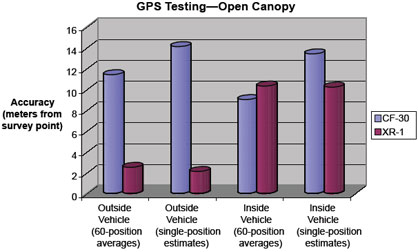Evaluation of Two Fully Rugged Laptop Computers for the Forest Service
Appendix F—GPS Tests
Purpose
The GPS tests were conducted to determine the expected accuracy of the GPS receivers in each laptop. While these laptops probably would never be used to obtain highly accurate GPS readings, the GPS receivers should be reasonably accurate. Law enforcement officers and research personnel may need relatively good accuracy (within 15 m) when obtaining field data.
The laptops were tested for GPS accuracy in the open and under a forested canopy. MTDC has a test course at the University of Montana's Lubrecht Experimental Forest for testing GPS receivers under a forested canopy. MTDC also has survey markers on its campus to test open-canopy situations.
The National Standard for Spatial Data Accuracy (NSSDA) was used to evaluate and report the GPS receiver's positional accuracy. The Federal Geographic Data Committee specifies that the NSSDA be used to evaluate and report the positional accuracy of geospatial data produced, revised, or disseminated by or for the Federal Government.
The NSSDA reports accuracy values at the 95 percent confidence level. In other words, only 1 out of 20 measurements made with the same receiver and data logging settings under similar forest canopy conditions should have errors larger than those published in this report.
Equipment
ArcPad 7.0 was installed on both laptops to obtain GPS locations. The CF-30 laptop was tested in a vehicle when it was docked and undocked in a vehicle mount. The mount has a pass-through antenna that can be placed on top of a vehicle.
The GPS receivers were configured to use the Wide-Area Augmentation System (WAAS) for improved accuracy. The system did not work on the CF-30 laptop. Panasonic technicians were working on the problem when the tests were conducted. Later they resolved the problem, but preliminary test results showed little difference in the accuracy of the GPS unit in the CF-30 laptop, with or without WAAS.
Procedure
Each laptop was tested both inside and outside of a vehicle. When the laptops were tested outside of a vehicle, they were held over a known, surveyed position. When they were tested inside a vehicle, an offset was determined from the surveyed position to establish the known position. In addition, the CF-30 laptop was tested in a vehicle mount with a connection for an external antenna.
- 60-Position Averages—ArcPad was configured to store a position determined
by averaging 60 single positions estimated by the GPS. Ten of these 60-second averages were taken.
- Single-Position Estimates—ArcPad was configured to store a single position (not averaged) estimated by the GPS.
Both 60-position averages and single-position estimates were recorded.
For tests outside the vehicle, the laptops were carried through a test course of seven known positions.
Results
Figures F–1 and F–2 show the results of the GPS accuracy tests.
The XR-1 laptop, which used the WAAS system, typically had more accurate results than the CF-30 laptop.

Figure F–1—Results from the open-canopy GPS accuracy
tests at the
MTDC survey point. Accuracy results are
based on
National Standard for Spatial Data Accuracy
formulas. Lower values mean better
accuracy.

Figure F–2—Results from the forested canopy GPS accuracy
tests at
the Lubrecht Experimental Forest GPS test course.
Accuracy results are based on National Standard for Spatial
Data Accuracy formulas.
Lower values mean better accuracy.
Conclusions
Results of the GPS tests show that the XR-1 laptop has better GPS accuracy than the CF-30 laptop. For most users, highly accurate positions are not necessary. However, most handheld GPS receivers tested by MTDC have about 15-m accuracy when used under a forest canopy, much better than the 40-m accuracy of the GPS receiver in the CF-30 laptop.
According to Panasonic representatives, the CF-30 laptop should be using the WAAS signal. Two technicians came to Missoula on August 27, 2007, to investigate the problem, but were not able to solve it on location. Later, they resolved the problem. Preliminary test results showed little difference in the GPS receiver's accuracy, with or without WAAS.
